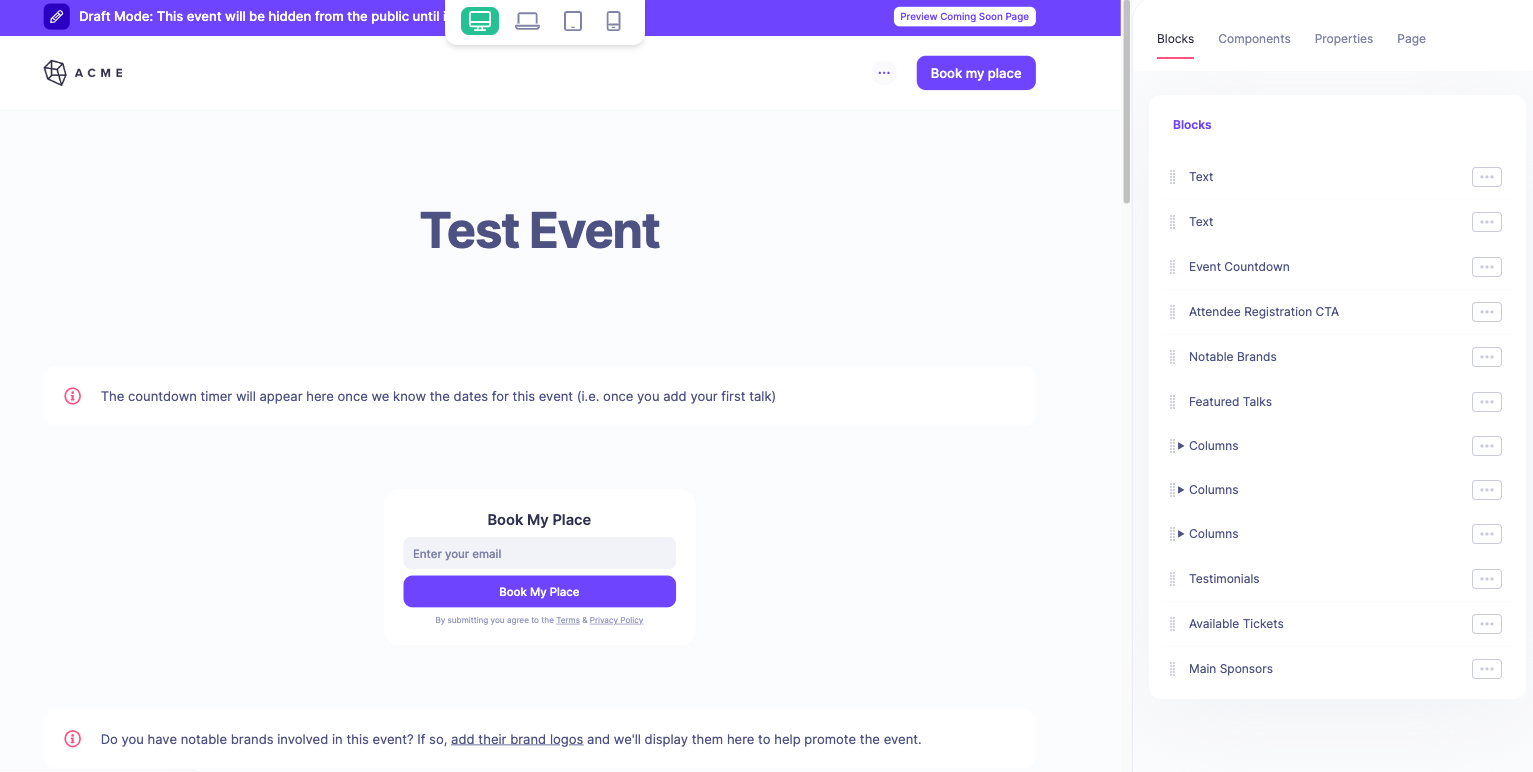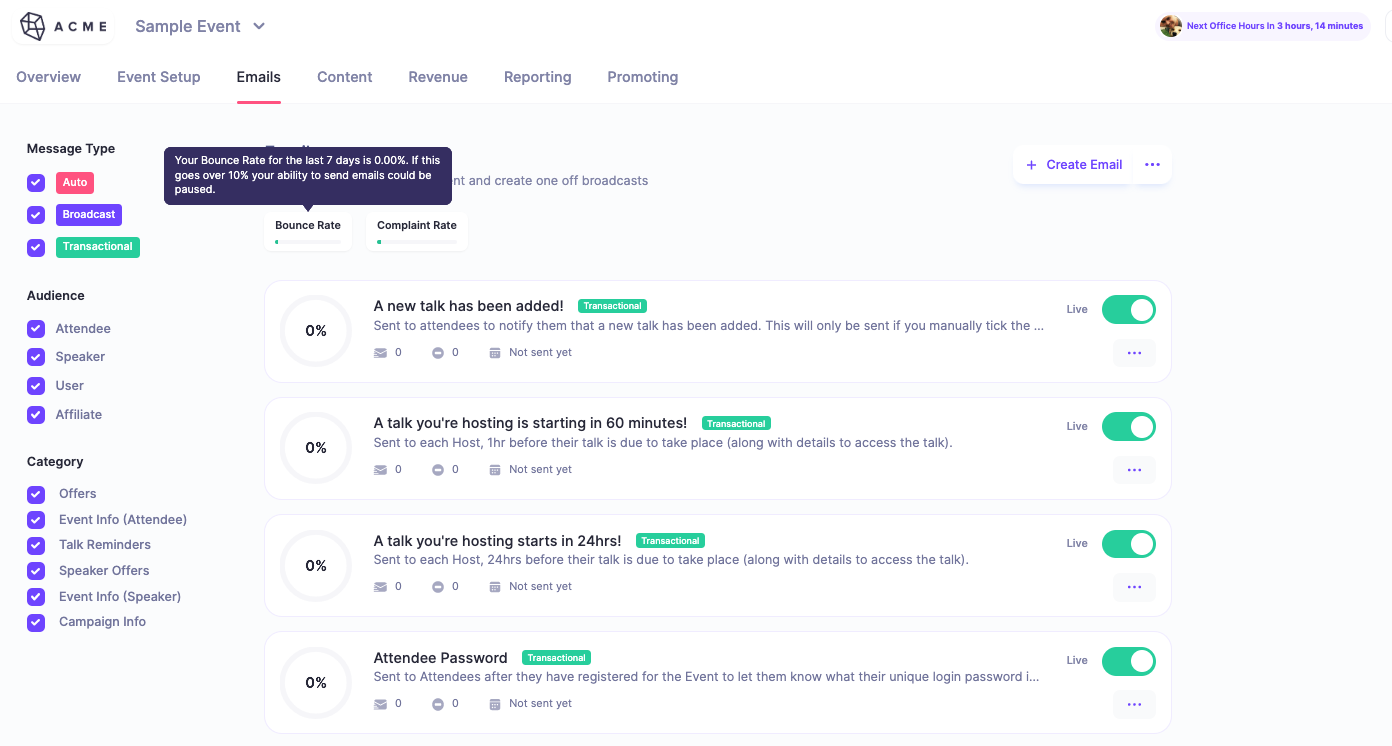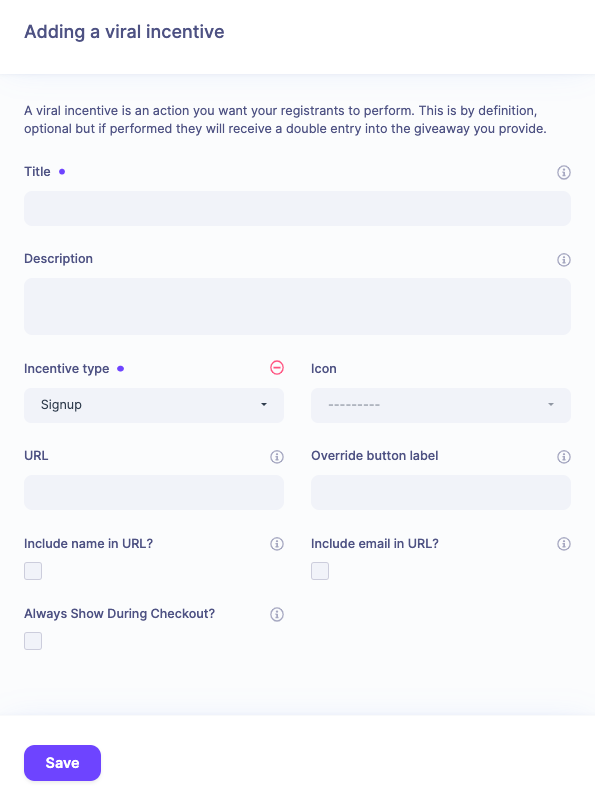How to Create a Virtual Event in 9 Easy Steps
Astley Cervania
Content Contributor, HeySummit
The global market size of virtual events is predicted to hit $657.64 billion by 2030, according to a report by Grand View Research.
That’s a pretty hefty number if you ask me…
More businesses than ever have adapted to online events since the COVID-19 pandemic. But even if you’re only just starting out, the virtual conference will be here for years to come.
In this complete guide, you’ll learn how to create a virtual event that not only offers an exceptional experience for your attendees but also achieves your business goals.
What Is a Virtual Event?
A virtual event is an event that happens entirely online rather than in person. Think of it as a video call on steroids – the difference between a normal video call and a virtual event is that the latter involves a lot more people and organized activities.
Virtual events take on many forms, such as conferences, summits, and trade shows. These may include activities such as networking and Q&As. Event organizers present to attendees either through live streaming or pre-recorded video, often by using an event management platform such as:
7 Best Practices to Keep in Mind When Hosting Virtual Conferences

When creating virtual events, you need to consider some basics before getting into the details of your action plan
Set clear event goals to work towards
Do at least one event practice run
Tailor your content to a specific type of attendee
Prioritize audience interaction
Offer attendee networking opportunities
Collect feedback
Send email reminders and follow-ups
How to Create a Virtual Event That Delivers an Exceptional Attendee Experience
Before we talk about the what of hosting a virtual event, let’s talk about the how.
There are two ways to create a virtual event: by yourself with multiple software tools or with an all-in-one virtual event platform.
A virtual events platform becomes your venue. This is where you’ll bring together attendees, set up the stage for your speakers, and carry out all of the logistics, from setting up signs so attendees know where to go to distributing agendas so everyone knows which sessions are on.
Without a virtual event solution, you’ll have to focus on the technical aspects of running an event as opposed to being solely focused on:
Building relationships with your speakers
Driving attendance
Managing sponsorsHere are a few simple steps for creating a virtual event:
1. Determine the Event Format
Here are a some examples of virtual event formats:
Live Q&As
Fireside chat
Webinars
You can also get some more inspiration from this post.
The best format depends on your audience’s interests. Refer to your attendee personas and consider what type of event would best meet their needs.
2. Make a List of the Right Tools
Think about the tools you’d need your platform to support – from features like enabling audience participation (chat, polls) to having multiple speakers present at once… Hosting an engaging online event requires several tools if you’re going to deliver an immersive experience.
Method 1: Hunt for Resources 🛠️
Here are some of the tools that are typically needed to create virtual events:
Video conferencing: Hosting an online event requires online video calls. Platforms like Zoom, Microsoft Teams, and Google Meet are popular choices.
Audio and video equipment: Good microphones, webcams, and lighting kits enable you to deliver a high-quality online experience.
Presentation: Using slides or other visual elements during your event may require presentation software such as Microsoft PowerPoint or Google Slides.
Interactive features: Boost attendee engagement with interactive features such as polls, live chat, and DMs. Popular tools here include Kahoot and Slido.
Ticketing system: Allow guests to purchase tickets and manage payments using software like Stripe or PayPal.
Analytics: Using software like Google Analytics to record data and measure event performance allows you to track your key performance indicators.
Content management: Whether that’s email or social media, you’ll better manage a volume of content using a platform such as Klaviyo and Buffer.
Method 2: Use HeySummit ⛰️
Instead of using a combination of the above tools, you could use an all-in-one solution that intuitively knows how to run a virtual event. You simply let the tool know the type of event you’re looking to create.

After filling out the fields provided, you’ll have access to all the tools you need to customize and manage your event in one place:
Landing page builder
Dynamic components
Drag-and-drop model
Pre-built themes
Custom CSS
Talk management
Rich descriptions and linked media
Video delivery options (live or pre-recorded video)
Automatic replays
Optional offers and giveaways
Registration stats
Speaker dashboard
Update talk details
Optional offers and giveaways
Auto-created graphics
Auto-created affiliate setups
Live registration stats
Speaker directory
Over 1,000 speakers available to work with
Filtering options
Rich speaker profiles
Contact forms
Attendee registration
Custom registration questions
Terms and conditions
Viral incentives
Ticketing management
Registration stats
Marketing and Viral Tools
Pre-registration page
Affiliate programs
Email management
Swipe copy
Testimonials
Ticket and revenue management
Local currencies
Set countdown timers
Content restrictions
Day restrictions
Ticket expiration
Pricing tiers
Reporting and analytics
Attendee segmentation
Webinar usage reports
Analytics dashboard
3. Choose an Event Time and Date
The time and date have an impact on the success of your event. With that in mind, consider the following:
Time Zones: Choose a time that works best for your target audience.
Days of the week: Consider what day of the week would be most convenient for your audience.
Clashing events: Double-check the calendar to ensure there aren’t any conflicting events or holidays that may affect attendance.
Event duration: Decide on the length of your event that your audience would prefer.
Follow-ups: Schedule the event taking into account how you’re going to follow up with attendees and engage with them post-event, e.g. surveys and scheduling additional meetings.
Pre-event marketing: Give yourself enough time to promote the event and build excitement beforehand to increase attendance rates.
4. Create Talk Sessions
Talk sessions are presentations or discussions that take place during an event. Examples of talk sessions include:
Keynote speeches
Panel discussions
Workshops
These are covered by speakers who are experts on a particular topic and are the simplest way to engage attendees.
The purpose is to give value to attendees by sharing insightful information and ideas for their benefit.
Here are the two ways you can host talk sessions when hosting a virtual event:
Method 1: Hunt for Resources 🛠️
You’ll need to choose a video-hosting platform like Vimeo or YouTube.
To set up a live session, you’ll need to choose a live webinar (or live streaming) platform like Zoom or BigMarker.
You could also mix in both types of recordings. A good example of this is adding a live Q&A session right after a talk or an info-heavy presentation to provide context before a panel discussion.
If you’re using existing content and live-stream videos, you’ll have to use multiple platforms to host your sessions and design a system to operate between these different resources. However, this gets difficult real quick especially when you’re running 10+ sessions a day.
Aside from that, you’ll also have to find a way to provide speakers behind-the-scenes access so they can update details about their talk sessions and have the option to add giveaways or offers. A few examples of ways to manage this are through:
Email communication
Using a shared document
Scheduling regular calls
Method 2: Use HeySummit ⛰️
When you use a tool that has everything you need for live streaming, you take the hassle out of trying to juggle multiple tools at once. With HeySummit, you have four ways to broadcast your event talks:
Live webinar: sync with one of our webinar platform integrations such as Zoom.
Custom stream: use an external URL if preferred.
Pre-recorded: include a link to the video.
No broadcast: send attendees straight to the replays.
We also offer video streaming integrations with WebEx, LiveWebinar, and more. We make the entire process simple so you can seamlessly mix different talk session formats.
It’s also easy for speakers to update their profile as they’ll have a dedicated space on HeySummit’s speaker dashboard. Instead of leaving them out in the dark and doing constant back-and-forths, your speakers can do the following:
Keep on top of swipe copy and promotional materials
Track live registration and attendee stats
Register as an affiliate (optional)
Share relevant links to attendees where they can see their schedules and sessions
Pro recommendation: test out your sessions from an attendee’s POV! We always suggest doing event practice runs before launching the real thing to ensure everything runs smoothly as you intended.
5. Set Up Ticketing Options
Much like an in-person event, when you create events online, you need to sell tickets so you can gauge the interest ahead of time. When attendees purchase tickets, it usually involves a unique identifier such as a barcode, QR code, or password to give them access to the event.
How to sell tickets for your virtual events:
Method 1: Hunt for Resources 🛠️
Ticketing involves the use of a third-party ticketing platform or service provider for managing the sales and distribution of tickets.
Event organizers can sell tickets directly through their own website or through ticketing providers like Ticketmaster, Eventbrite, and StubHub. Through these platforms, you’re able to impose limits, such as providing free tickets for a limited period of time and establishing pricing tiers.
Whatever you decide, you’ll need to set this up alongside a registration form. You’ll also need to facilitate payments as tickets (unfortunately) can’t sell themselves.
Here’s what we’d suggest reviewing in a ticketing and payment platform:
Security
Reliability
Ease of use
Currency conversions
Ticket handling fees
Method 2: Use HeySummit ⛰️
Whether your event tickets are going to be free, paid, or a mixture of both, the easiest way is to set up ticketing is to use HeySummit. The tool allows you to:
Offer coupon codes
Include ticket restrictions
Share offers
Share giveaways
Manage affiliate payouts
Manage sponsorship
You’ll also have a full record of all event attendees who purchased tickets.
Having all the information and settings in one place is a real lifesaver, especially when attendees want to make changes to their ticket type or when you want to find out which type of ticket is selling the most.
Pro recommendation: have multiple tiers with ticket pricing (including free options). Everyone loves free events and discounted tickets, including sponsors, because they attract higher attendance numbers.
6. Build an Event Landing Page
An event landing page is a standalone web page created specifically for advertising your event. It’s where someone ‘lands’ when they enter your event URL or when they click on the link promoted through your ads or marketing copy.
Showcase both your brand and the essential event details. This is key for making a solid first impression and setting up your event for success.
Method 1: Hunt for Resources 🛠️
Here are a few key f details your event landing page should include:
Event title
Unique value proposition
Dates of the event
The event host (your name/company name)
Speaker or talk session details
Taster videos
Customer testimonials
If you’re creating your event landing pages manually, you’ll need to use a landing page builder or a CMS like WordPress or hire a website designer to do the work for you.
Method 2: Use HeySummit ⛰️
After following the step-by-step process and entering your event details into HeySummit, a landing page is created that you can customize for your brand.
In other words, generate your landing pages automatically simply by entering your event details.
It’s also equally straightforward to edit your landing page thanks to the drag-and-drop model with pre-built components:
Make tweaks to your landing page design by adding text, images, logos, and banners so that it reflects your brand’s style and tone (our platform includes guidance on image optimization, so there’s no need for guesswork)
Implement changes instantly to your landing page whenever you update event content
Move content around the landing page based on both your preferences and your ideal attendee’s preferences
Include a countdown timer after adding your first talk to optimize your event landing page for higher conversions
Get access to HeySummit’s built-in rich schema markup so that Google makes your content on search results stand out
No coding skills are required. HeySummit has a simple layout, as shown below.

7. Have a Plan for Email Marketing
You’ve got the speakers on board and a list of attendees who signed up. Now, it’s crucial to keep the momentum going by building brand awareness and a buzz leading up to the event. This is a huge part of driving a highly engaged audience to your sessions, which is where email marketing comes in.
Managing emails is essential for:
Event planning and execution
Streamlining communication
Maximizing marketing efforts
Overall, email helps event hosts communicate effectively, stay organized, promote the event, and reinforce branding.
Method 1: Hunt for Resources 🛠️
You’ll often collect attendee emails from the signup form on your landing page. So, import the email list into a platform like Mailchimp then start sending personalized email sequences.
An email marketing platform would be useful thanks to features like:
Automated email campaigns
Email analytics
This also helps to ensure you and your team are all on the same page.
Another method is to communicate with your audience through social media or to add attendees to a private community page. But, most event organizers go the email route because people are more likely to read information sent to them personally via email rather than information that’s posted on a public page.
Method 2: Use HeySummit ⛰️
All HeySummit accounts come with pre-written customizable email templates. Plus, you’ll be able to schedule emails so that they’re sent to attendees automatically instead of having to send each email yourself.
You’ll get a range of email templates, such as:
Welcome message
Daily agenda
Event reminders with session details and how to access them (with links)
Showcase of event highlights
Wrap up message
And more…
On your email dashboard, you’ll also see bounce rates and complaint rates, as shown below.

In short, you’ll get access to the main features that you would normally see in email marketing software, except it’s embedded within HeySummit.
8. Promote Your Event
Without promoting your event, not as many people are going to show up.
A winning event marketing strategy generates awareness and interest, which leads to attendance and ticket sales. You’ll want to find creative ways to get the word out about your event. Here are some ideas:
Method 1: Hunt for Resources or Execute Your Strategy Manually 🛠️
On top of email marketing (which is pretty much essential for promoting a virtual event), here are a few other strategies you might implement:
Schedule regular social media posts using a platform like Buffer
Use paid ads to reach a specific demographic
Set up an affiliate program using affiliate marketing software
Give incentives to attendees to help spread the word
Do giveaways
Offer early bird discounts
Partner up with influencers in your niche
Your speaker, existing customers, and affiliates are some of your biggest marketing assets. People are more likely to trust and buy from a brand that’s recommended by someone they know or resonate with.
So, consider doubling down on word-of-mouth marketing because it tends to lead to more sales and influence compared to all other forms of advertising!
Method 2: Use HeySummit ⛰️
All the marketing tools and features that you need for your event are built-in with HeySummit, such as:
Affiliate programs
Email management
Sponsorship marketing
Promotional banners
Viral incentives
Swipe copy
Testimonial marketing
Again, this is a step-by-step process. Or some of the above is automatically generated for you, e.g., speaker and talk promo banners.
Here’s a sample process for setting up viral incentives using HeySummit:
1. Head over to the “content tab”.

2. Fill in the form provided as shown below.

3. Press “save" and you're all done!
9. Have Tech Support Ready
There’s always going to be a possibility of technical issues arising during an event, even when you’ve done a few practice runs beforehand.
Method 1: Learn How to Resolve the Technical Issues Yourself or Hire an Experienced Professional 🛠️
Test run your event before launching it live. Next, research the potential technical errors that could arise and how to overcome them.
Since you’re operating alone or with a small team without external support, make yourselves familiar with the ins and outs of each software that you’re using so you can fix any errors that might come up.
Another option is to hire an experienced professional. Then again, this can sometimes be even more costly compared to using a platform like HeySummit.
Method 2: Use HeySummit ⛰️
Things are 10 times easier when you get step-by-step guidance and support from a team that lives and breathes online events. And in many cases, it eliminates the need to hire someone with design and coding experience.
At HeySummit, we guide you through the entire process from start to finish.
We tell you what details to plug in, where it goes, and what to take into account so that you can put together a winning virtual event.
Here’s what one of our users, Larry, had to say about our team:
“They are incredibly responsive and thoughtful and really care about my questions and technical needs! This is huge for me, and it has been a great confirmation that I chose the best possible platform for my events. I can count on the team at HeySummit to be so responsive and to care so much for all of the small details that ultimately help me produce a successful virtual summit.”
Get started now with HeySummit by signing up here for a free 14-day trial.
What About Zoom and Google Meet, Can’t You Create a Virtual Event There?
Zoom and Google Meet are designed as video conference platforms, so they may not be sufficient for hosting large virtual events because:
Limited customization options to deliver a fully branded online experience
Offers no features or dashboards for managing keynote speakers and getting sponsors engaged
Plans don’t include ticketing features or tools to optimize for higher sales revenue
Limited technical support
Although Zoom has some useful features, like creating breakout sessions, it’s not optimized for building a virtual environment.
I mean, you could run a webinar or a small online event, but it’s a different story when it comes to putting together large virtual events involving third-party speakers, sponsors, and affiliates.
Conclusion
Now, you know how to create a virtual event by yourself and by using an all-in-one tool like HeySummit.
Although it’s completely doable to go at it on your own, it is going to cost a lot more time and effort, which can ultimately impact your bottom line. By using an affordable online platform like HeySummit, to deliver your next virtual event, not only will it make your life easier, but your audience will be impressed by the ease with which they can register, attend, and engage with your event. It’s never been simpler to be a crowd-pleaser!
See for yourself and start a free 14-day trial here.
Table of Contents
What Is a Virtual Event?7 Best Practices to Keep in Mind When Hosting Virtual ConferencesHow to Create a Virtual Event That Delivers an Exceptional Attendee ExperienceWhat About Zoom and Google Meet, Can’t You Create a Virtual Event There?ConclusionTry HeySummit free
HeySummit is the easiest way for creators and educators to grow their audience, authority and revenue with professional online events created in minutes, not weeks.
Share this article on:
Recent Posts
Loading feed...